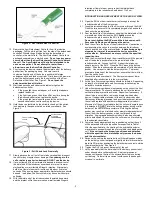
- 4 -
attached to the delivery pusher and attempt another detachment
cycle when the light turns green.
38. The light will turn red after the number of detachment cycles
specified on the Azur Detachment Controller labeling. DO NOT
use the Azur Detachment Controller if the light is red. Discard the
Azur Detachment Controller and replace it with a new one when
the light is red.
39. Verify detachment of the coil by first loosening the RHV valve,
then pulling back slowly on the delivery system and verifying that
there is no coil movement. If the implant did not detach, do not
attempt to detach it more than two additional times. If it does not
detach after the third attempt, remove the delivery system.
40. After detachment has been confirmed, slowly retract and remove
the delivery pusher.
Advancing the delivery pusher once the
coil has been detached involves the risk of aneurysm or
vessel rupture. Do NOT advance the delivery pusher once the
coil has been detached.
41. Verify the position of the coil angiographically.
42. Additional coils may be deployed into the lesion as described
above. Prior to removing the catheter from the treatment site,
place an appropriately sized guidewire completely through the
catheter lumen to ensure that no part of the last coil remains
within the catheter.
The physician has the discretion to modify the coil deployment
technique to accommodate the complexity and variation in
embolization procedures. Any technique modifications must be
consistent with the previously described procedures, warnings,
precautions and patient safety information.
SPECIFICATIONS FOR AZUR DETACHMENT CONTROLLER
Output voltage: 8 ± 1 VDC
Cleaning, preventative inspection, and maintenance: The
Azur Detachment Controller is a single use device,
preloaded with battery power, and packaged sterile. No
cleaning, inspection, or maintenance is required. If the
device does not perform as described in the Detachment
section of these Instructions, discard the Azur Detachment
Controller and replace it with a new unit.
The Azur Detachment Controller is a single use device. Do
not reuse, reprocess or resterilize. Reuse, reprocessing or
resterilization may compromise the structural integrity of the
device and/or lead to device failure which, in turn, may result
in patient injury, illness, or death. Reuse, reprocessing, or
resterilization may also create a risk of contamination of the
device and/or cause patient infection or cross-infection,
including, but not limited to, the transmission of infectious
disease(s) from one patient to another. Contamination of the
device may lead to injury, illness or death of the patient.
Batteries are pre-loaded into the Azur Detachment
Controllers. Do not attempt to remove or replace the
batteries prior to use.
After use, dispose of the Azur Detachment Controller in a
manner consistent with local regulations.
PACKAGING AND STORAGE
The Azur system is placed inside a protective, plastic dispenser
hoop and packaged in a pouch and unit carton. The Azur system
and dispenser hoop will remain sterile unless the package is
opened, damaged, or the expiration date has passed. Store at a
controlled room temperature in a dry place.
The Azur Detachment Controller is packaged separately in a
protective pouch and carton. The Azur Detachment Controller
has been sterilized; it will remain sterile unless the pouch is
opened, damaged, or the expiration date has passed. Store at a
controlled room temperature in a dry place.
SHELF LIFE
See the product label for the device shelf life. Do not use the
device beyond the labeled shelf life.
MR INFORMATION
Non-clinical testing demonstrated that the coil implant is
MR
conditional
. A patient can be scanned safely, immediately after
placement under the following conditions:
Static magnetic field of 1.5 and 3 Tesla, with
Maximum spatial gradient field of 5000 Gauss/cm
Theoretically estimated maximum whole body average
(WBA) specific absorption rate (SAR) of < 2W/kg
(Normal Operating Mode)
MRI-Related Heating
Under the scan conditions above, and 15 minutes of continuous
scanning, the coil implant is expected to produce a maximum
temperature rise of 1.3°C
Image Artifact Information
MR image quality may be compromised if the area of interest is in
the exact same area or relatively close to the position of the coil
implant. Therefore, optimization of MR imaging parameters to
compensate for the presence of this device may be necessary.
In non-clinical testing, the image artifact caused by the coil
implant extends approximately 41.3mm in diameter and 21.3mm
in height from the implant when imaged with a gradient and spin
echo pulse sequence and a 3 Tesla MR system.
Terumo Corporation recommends that the patient register the MR
conditions disclosed in this IFU with the MedicAlert Foundation or
equivalent organization.
MATERIALS
The Azur system does not contain latex or PVC materials.
SYMBOLS
Lot Number
Order Number
Content
Sterilized Using Irradiation
Sterilized Using Ethylene Oxide
Do Not Reuse
Use-by Date
Date of Manufacture
Attention, Consult Accompanying Documents
Type BF Applied Part



















